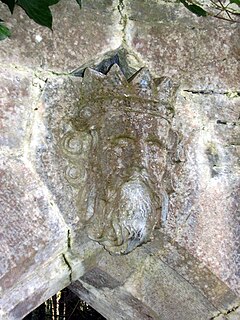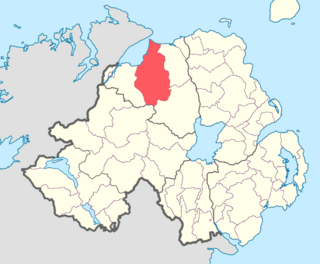| |||||
| Centuries: | |||||
|---|---|---|---|---|---|
| Decades: | |||||
| See also: | Other events of 1241 List of years in Ireland | ||||
Events from the year 1241 in Ireland.
| |||||
| Centuries: | |||||
|---|---|---|---|---|---|
| Decades: | |||||
| See also: | Other events of 1241 List of years in Ireland | ||||
Events from the year 1241 in Ireland.

Year 1241 (MCCXLI) was a common year starting on Tuesday of the Julian calendar.

Ruaidrí mac Tairrdelbach Ua Conchobair was King of Connacht from 1156 to 1186, and High King of Ireland from 1166 to 1198. He was the last High King of Ireland before the Anglo-Normans invaded Ireland. Ruaidrí was the last native and Celtic King of Ireland.

Thomond, also known as the kingdom of Limerick, was a kingdom of Gaelic Ireland, associated geographically with present-day County Clare and County Limerick, as well as parts of County Tipperary around Nenagh and its hinterland. The kingdom represented the core homeland of the Dál gCais people, although there were other Gaels in the area such as the Éile and Eóganachta, and even the Norse of Limerick. It existed from the collapse of the Kingdom of Munster in the 12th century as competition between the Ó Briain and the Mac Cárthaigh led to the schism between Thomond and Desmond. It continued to exist outside of the Anglo-Norman controlled Lordship of Ireland until the 16th century.
Hugh Roe O'Donnell, also known as Red Hugh O'Donnell, was a sixteenth-century Irish nobleman. He became Chief of the Name of Clan O'Donnell and Lord of Tyrconnell in 1593 after a succession dispute within the O'Donnell dynasty, and after escaping a five-year imprisonment in Dublin Castle by the English. Along with his father-in-law Hugh O'Neill of Tyrone, he led an alliance of Irish clans in the Nine Years' War against the English government in Ireland. Hugh Roe led an Irish army to victory in the Battle of Curlew Pass. After defeat in the Siege of Kinsale, he travelled to Spain to seek support from King Philip III. Unsuccessful, he died in Spain and was succeeded by his younger brother Rory O'Donnell. He is sometimes also known as Aodh Ruadh II or Red Hugh II, especially in his native County Donegal.

The Kings of Ailech were the over-kings of the medieval Irish province of Ailech in north-western Ireland. It encompassed the territories of the Cenél nEógain and Cenél Conaill. After the battle of Cloítech in 789 its kings were exclusively from the Cenél nEógain. The royal fort for Ailech was the Grianan of Aileach, a hillfort on top of Greenan Mountain in modern-day County Donegal, Republic of Ireland.
Clan Sweeney is an Irish clan of Scottish origin. The Mac Suibhne family did not permanently settle in Ireland before the beginning of the 14th century, when they became Gallowglass soldiers for the Ua Domnaill dynasty of Tír Chonaill. The clan also claims an Irish descent from a prince of the Uí Néill dynasty, Ánrothán Ua Néill, son of Áed, son of Flaithbertach Ua Néill, King of Ailech and Cenél nEógain, died 1036. Through this descent the clan can claim a descent from Niall Noigíallach.

Tír Eoghain, also known as Tyrone, was a kingdom and later earldom of Gaelic Ireland, comprising parts of present-day County Tyrone, County Armagh and County Londonderry. The kingdom represented the core homeland of the Cenél nEógain people of the Northern Uí Néill and although they ruled, there were smaller groups of other Gaels in the area. Also known as the guidance of Land. One part of the realm to the north-east broke away and expanded, becoming Clandeboye, ruled by a scion branch of the O'Neill dynasty.
Domhnall ua Néill was High King of Ireland from 956 to 980.
Events from the year 1177 in Ireland.

The Earldom of Ulster was an Anglo-Norman lordship in northern medieval Ireland, established by John de Courcy from the conquest of the province of Ulaid in eastern Ulster. It was the most important Anglo-Norman lordship in the north of Ireland. At its greatest extent it extended as far west as the Inishowen peninsula in modern-day County Donegal, which was at one time the power-base of the Northern Uí Néill.
Events from the year 1566 in Ireland.

Keenaght is a barony in the mid-northerly third of County Londonderry, Northern Ireland. It connects to the north-Londonderry coastline, and is bordered by four other baronies: Coleraine to the east; Loughinsholin to the south-east; Tirkeeran to the west; and Strabane Upper to the south-west. It was the territory of the Cianachta Glengiven from the 5th century until its takeover in the 12th century by the Ó Cathaín's. The largest settlement in the barony is the town of Limavady.
Thomas of Galloway, known in Gaelic sources as Tomás Mac Uchtraigh, was a Gall-Gaidhil prince and adventurer. The son of Lochlann, king of Galloway, Thomas was an active agent of his brother Alan of Galloway as well as the English and Scottish kings. When King John, the English monarch, decided that central and western Ulster were to be added to his dominions, he conscripted Thomas and Alan of Galloway to his aid, offering them much of later counties Antrim, Londonderry and Tyrone as incentive.
Áed in Macáem Tóinlesc or Aodh an Macaoimh Tóinleasg was a 12th-century ruler of Tulach Óc and Tír Eogain. He was the first of his family to play a significant role in the high politics of northern Ireland, following the death of the Muirchertach Mac Lochlainn king of Tír Eogain and high king of Ireland.
Aodh Méith or Áed Méith was a 13th-century king of Tír Eoghain. The son of Aodh an Macaoimh Tóinleasg, Aodh spent much of his career fighting off threats from Fir Manach, Tír Conaill and Galloway, as well as John de Courcy and the Lordship of Ireland. His involvement in Irish Sea politics may have seen him sponsor a Mac Uilleim claim to the Scottish throne, but this is unclear.
Events from the year 1167 in Ireland.
Donnell Claragh O'Neill, was a member of the O'Neill Dynasty of Tír Eoghain, Ulster in medieval Ireland. He was the son of Con O'Neill, and a half-brother to Henry Oge O'Neill. He succeeded Henry as chief of the O'Neills, and ruled from 1498-1509. He was in turn succeeded by a cousin Art O'Neill.
The Meic Lochlann, also spelt as Mic Lochlainn, and Mac Lochlainn, were a leading branch of the Cenél nEógain, who were in turn a segment of the Uí Néill. The Meic Lochlainn descended from Domnall Dabaill, son of Áed Findliath. Another son of the latter was Niall Glúndub eponymous ancestor of the Ua Néill. As a result of their descent from Domnall Dabaill, the Meic Lochlainn were known as Clann Domnaill or Clann Domhnaill. The eponym behind the surnames of the Meic Lochlainn—Mac Lochlainn, Ua Lochlainn, Ó Lochlainn—is Lochlann mac Máelsechnaill, King of Inishowen. The surnames themselves formed not as a result of Lochlann's prominence, but as a consequence of the remarkable success of his grandson, Domnall Ua Lochlainn.
Donnell Óg O'Donnell, was a medieval Irish king of Tyrconnell and member of the O'Donnell dynasty. He was a leading figure in the resistance to Anglo-Norman rule in the north west and closely related to many of the movement's most prominent figures, such as Hugh McFelim O'Connor, who is often credited as being the first to import Scottish gallowglass warriors. He should not be confused with a descendant of the same name who was a nephew of Rory O'Donnell, 1st Earl of Tyrconnell, and was the ultimate beneficiary-in-remainder to the Lordship of Tyrconnell.